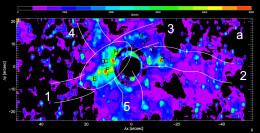The cosmic web is a vast, foam-like network of filaments and voids stretching throughout the universe. How did the first galaxies form within the cosmic web, at the intersections of filaments? New observations of a “protodisk” — a galaxy in the early stages of formation — may provide a clue.
Models for Galaxy Formation

Narrowband image of the candidate protodisk (marked with a white ellipse) and filaments (outlined in white). [Adapted from Martin et al. 2016]
But what if galaxies are actually formed from cool gas? In this contrasting picture, the “cold accretion model,” cool (temperature of ~104 K) unshocked gas from cosmic web filaments flows directly onto galactic disks forming at the filamentary intersections. The narrow streams of cold gas deliver fuel for star formation.
A signature of the cold accretion model is that the streams of cold gas form a disk as the gas spirals inward, sinking toward the central protogalaxy. Detecting these “cold-flow disks” could be strong evidence in support of this model — and last year, a team of authors reported just such a detection! This year they’re back again with a second object that may provide confirmation of cold accretion from the cosmic web.
A Candidate Protodisk
The team, led by Christopher Martin (California Institute of Technology), made the discovery using the Palomar Cosmic Web Imager, an instrument designed to observe faint emission from the intergalactic medium. Martin and collaborators found a large (R > 100 kpc, more than six times the radius of the Milky Way), rotating structure of hydrogen gas, illuminated by the nearby quasi-stellar object QSO HS1549+1919. The system is located at a redshift of z~2.8.
![Three potential kinematic models of the candidate protodisk and filaments. a) Two filaments feed the disk, b) one filament feeds the disk, seen at 1.5 Gyr, and c) same as b, but after only 1.1 Gyr. [Martin et al. 2016]](https://aasnova.org/wp-content/uploads/2016/06/fig32-260x130.jpg)
The authors test three potential kinematic models of the candidate protodisk and filaments. In (a) two filaments feed the disk, in (b) one filament feeds the disk, seen at 1.5 Gyr, and (c) is the same as (b), but after only 1.1 Gyr. [Martin et al. 2016]
This protodisk is very similar to the group’s previous discovery of a disk illuminated by QSO UM287. Their new discovery of a second such protodisk suggests that these objects may be common, and it confirms that cold-flow accretion is present at these redshifts. Searching for more of these objects will help us to better understand the specifics of how galaxies form from the cosmic web.
Citation
D. Christopher Martin et al 2016 ApJ 824 L5. doi:10.3847/2041-8205/824/1/L5

6 Comments
Pingback: galaxy formation: cold accretion from the cosmic web
Pingback: For Whom the Cosmic Web Tolls | astrobites
Pingback: Por quién dobla la red cósmica – Multi Work
Pingback: Por quién dobla la red cósmica – Xclusive 4 You
Pingback: Por quién dobla la red cósmica | Astrobites en español
Pingback: Is het ontstaan van sterrenstelsels wellicht verkeerd begrepen?